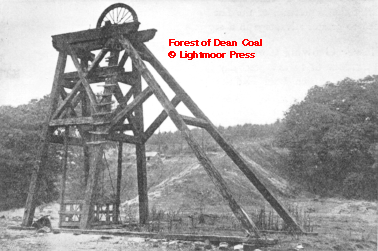
The headframe at Addis Hill after work
had ceased.
The gale was confirmed upon James Cowmeadow, a free miner from Cinderford, by the 1841 Awards although he had previously been working it, even though it had not been granted to him. An output figure for 1846 is listed against James Cowmeadow of 2074 tons although there would appear to have been no production between 1841 and 45. The history of the gale up until 1873 is unfortunately not recorded although as James Cowmeadow had died by April 1848 it can be assumed that there was a change in the registered owner. The gale probably passed into the hands of his widow, Elizabeth, as with another of his gales Cinderford Bridge Pit.
The date at which Elizabeth Cowmeadow disposed of the gale is unknown but after 1873 the gale formed part of the Haywood Colliery being worked by the Littledean Woodside Coal Co. This company was formed to acquire the Haywood and Addis Hill Collieries with a capital of £25,000 in 5,000 £5 shares. The directors were Edwin Crawshay, chairman, with 500 shares; Samuel Wilkinson Woods, five shares; Henry Richards Lückes and Francis Nash, five each; George Morgan, George Frederick Morgan and Thomas Smith, one share each. The company was incorporated in February 1873. At this time Crawshay was also trying to acquire the Richard Whites gale in order to extend the area although it would appear that he was unsuccessful in this until 1876. He did, however, add Smith´s Delight gale which was a strip of coal 58 chains long and 1 chain wide situated on the deep side of Haywood Pit to win the coal in the Coleford High Delf vein.
The Littledean Woodside Coal Co. had to borrow capital from the Standard Building Society but unfortunately the sum appears not to have been sufficient and the company went into liquidation in 1882 and was wound up voluntarily in February 1884. Crawshay carried on the works until 1885 when the building society itself was wound up. With the threat of losing his colliery Crawshay induced friends to find the capital to carry on. They formed the Haywood Colliery Co. Ltd. with Edwin Morgan as secretary. The output of the colliery for 1885 is recorded as being 7,821 tons in the six months to June 30th and 6,626 tons to December 31st giving an annual total of 14,447 tons.
The coal from Addis Hill was being worked through the upper part of Richard White´s gale which was leased from Edward Foxall, and was brought to the surface through Haywood Pit.
In April 1890 the colliery was sold to Richard Hadingham for the sum of £200. Work appears to have stopped by 1893 when it was reported that Addis Hill was liable for forfeiture. The gale was said to contain a large area of unworked coal. In March 1900 it was put up for auction again at the Wellington Hotel, Gloucester, with the registered owners at this time given as Richard Hadingham and Fred Morgan. It was said that there was 50-60 acres of unworked Coleford High Delf which could be worked either by means of a level ´close to the GWR´ or by means of a pit with 4-500 yards.
The purchaser appears to have been Albert Schofield. In 1906 he was wishing to drive a roadway to Inkerman Pit, which was part of Prosper Colliery, in order to provide a second outlet. In July 1907 he was applying for a license to maintain a short length of siding at Churchway which had previously been used by the New Bowson Co. Schofield appears to have been working Addis Hill from the Haywood Level and Pit although he had rigged up winding gear over a shaft which had formerly been used as a ventilation shaft on the Fairplay Iron Mine drainage adit. Potts Mining Register for 1908 records that Schofield was employing twenty-two below ground and four on the surface.
It would seem that Schofield had ceased work around 1910 and sold the gale in 1915. In February 1917 it was recorded in the Dean Forest Mercury that John H. Walby the proprietor of Addis Hill Colliery had been fined for failing to provide two exits and also for not employing a competant person over the age of twenty-two to work the winding machinery. It was stated that he had worked the mine for two years and that it had been idle for about five years before this.
In December 1920 the private siding agreement referring to the siding at Churchway was transferred to the Addis Hill Colliery Co. Again it is unknown whether the proprietor of this company was Walby.
In 1931 Mr. Ivo Baldwin, a coal factor of Ruardean, began working the gale but discontinued work in May 1935. The gale then reverted to the Crown and was regaled as Addis Hill No. 2 and conveyed to Ronald George Meek in February 1944 although it was not licensed under the National Coal Board in 1954 suggesting that no work was being done. Later the gale was in the hands of Frank Joynes.
Addis Hill was working the
eastern
crop of the Coleford High Delf, which at this point was between
1ft
6in. and 6ft 6n. thick, from the No. 4 airshaft on the Fairplay Level
(890
yards long) and the Brazilly seam from the No. 1 airshaft, no
intermediate
seam was worked from which it may be inferred that the Yorkley and
Whittington
seams were absent or very thin.

The headframe at Addis Hill after work
had ceased.